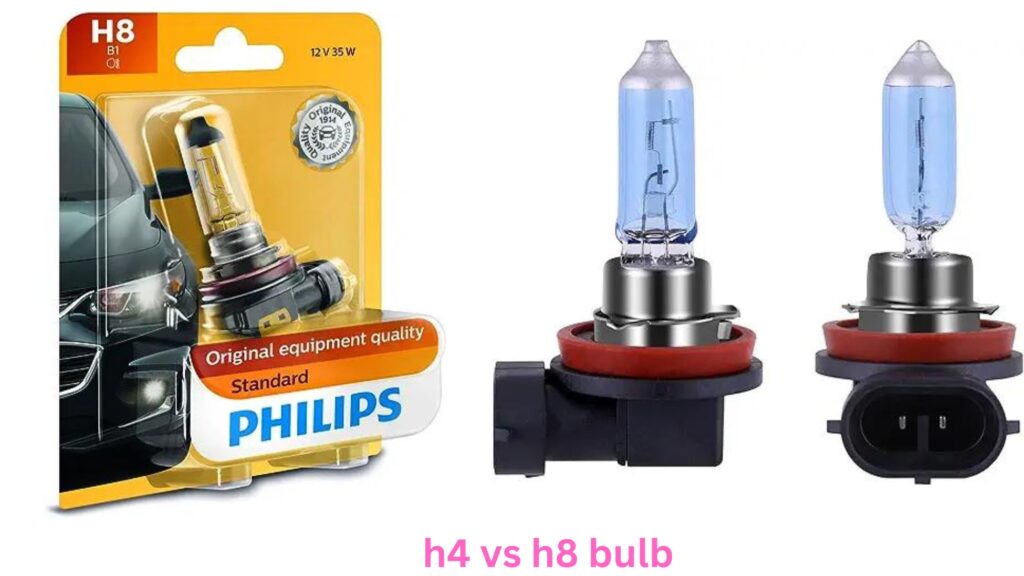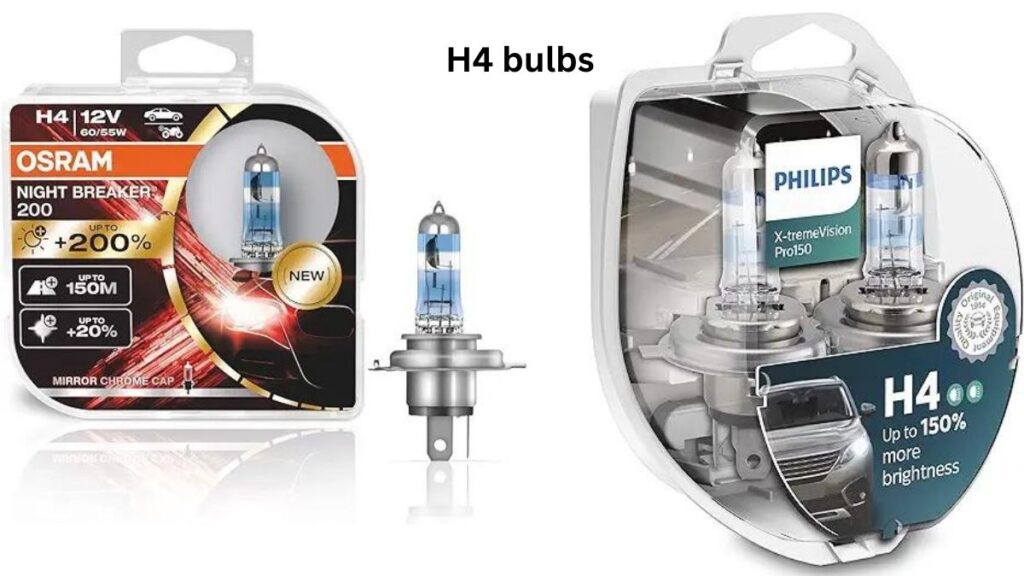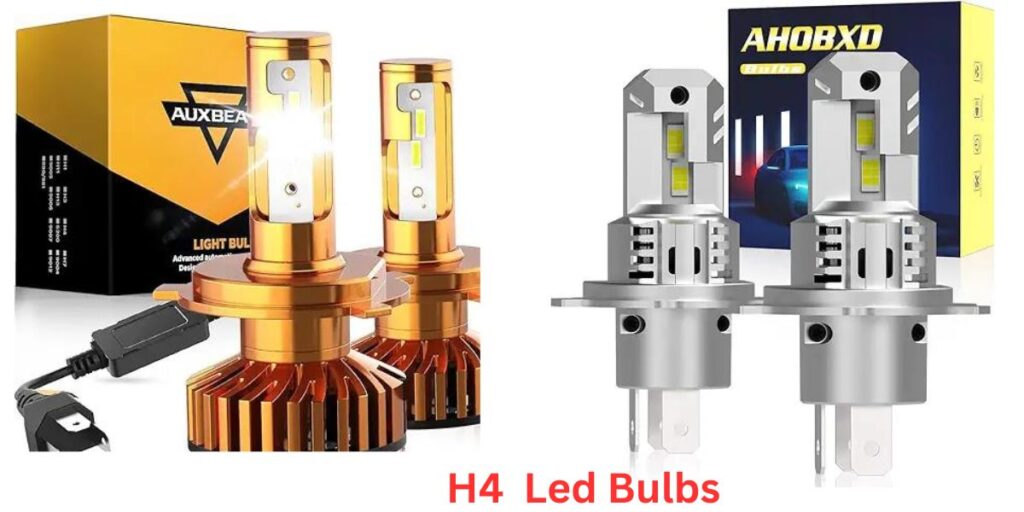Choosing the right headlight bulb for your vehicle is crucial for safety and performance. Among the many options available, H4 and H8 bulbs are often considered due to their specific characteristics. In this article, we’ll dive deep into the difference between H4 and H8 bulbs, helping you make an informed decision. Let’s explore each aspect in detail, using simple language and clear explanations.

What Are H4 and H8 Bulbs?
Definition and Basic Characteristics of H4 Bulbs
H4 bulbs are dual-filament bulbs, meaning they can provide both high and low beams from a single bulb. This dual functionality makes them a popular choice for a wide range of vehicles, especially older models and motorcycles. H4 bulbs are known for their versatility and have been in use for many years, offering a balance between performance and cost.
Definition and Basic Characteristics of H8 Bulbs
H8 bulbs, on the other hand, are single-filament bulbs, typically used for fog lights or low-beam headlights. They produce a more focused beam of light, which is ideal for specific driving conditions like fog or rain. H8 bulbs are commonly used in newer vehicles and are known for their precision in light output.
Brief History and Development of These Bulb Types
The H4 bulb has been around for decades, evolving from early halogen technology to more advanced LED and HID variants. Its dual-filament design has made it a staple in the automotive industry. The H8 bulb is a more recent development, designed to meet the needs of modern vehicles requiring precise lighting for specific conditions. Both bulbs have adapted over time to incorporate new technologies, but their core functions remain the same.
Physical Differences Between H4 and H8 Bulbs
1. Size and Shape Comparison
The H4 bulb is generally larger than the H8 bulb, with a more elongated shape. This size difference is due to the dual-filament configuration in H4 bulbs, which requires more space. The H8 bulb is more compact, making it easier to fit into smaller spaces, such as fog light housings.
2. Base and Connector Types
H4 bulbs typically have a P43t base, which is designed to fit into a wide range of headlight housings. The base of an H4 bulb is larger and more robust, ensuring a secure fit. H8 bulbs, on the other hand, have a PGJ19-1 base, which is smaller and more suited to compact applications like fog lights. The connectors for H8 bulbs are also different, designed to match their specific application.
3. Filament Configuration (Single vs. Dual)
As mentioned earlier, the H4 bulb features a dual-filament configuration, allowing it to serve both high and low beam functions. The H8 bulb is a single-filament bulb, designed for a specific purpose, such as fog lights or low beams. This difference in filament configuration is one of the key distinctions between these two bulb types.

Performance Characteristics
a). Brightness and Light Output Comparison
H4 bulbs offer a decent level of brightness, suitable for most driving conditions. However, because they have to balance both high and low beams, their brightness is somewhat compromised compared to single-purpose bulbs. H8 bulbs, being single-filament, provide a more focused and intense light output, especially in foggy or rainy conditions. If brightness is your priority, H8 bulbs might have the edge.
b). Beam Pattern Differences
The beam pattern of H4 bulbs is more versatile, offering both wide and focused beams depending on whether the high or low beam is in use. H8 bulbs produce a more narrow and concentrated beam, which is particularly useful in poor weather conditions where visibility is limited.
c). Color Temperature and Light Quality
Both H4 and H8 bulbs are available in various color temperatures, ranging from warm yellowish tones to cool white. Generally, H4 bulbs are designed for a broader spectrum of light, while H8 bulbs focus on producing a sharp, clear beam that cuts through fog and mist. The light quality of H8 bulbs tends to be more refined, offering better visibility in specific conditions.
Applications and Vehicle Compatibility
i). Common Uses for H4 Bulbs
H4 bulbs are commonly used in a wide range of vehicles, including motorcycles, older cars, and even some modern vehicles that require dual-function headlights. They are a popular choice for those who need both high and low beams from a single bulb, offering convenience and efficiency.
ii). Typical Applications for H8 Bulbs
H8 bulbs are most often found in fog lights and low-beam headlights. Their focused light output makes them ideal for situations where visibility is compromised, such as in fog or heavy rain. Many modern vehicles use H8 bulbs specifically for these applications, ensuring optimal performance in challenging conditions.
ii). Vehicle Types and Models That Use Each Bulb
H4 bulbs are used in a variety of vehicles, from motorcycles to older sedans and even some SUVs. They fit a variety of models because of their adaptability. H8 bulbs, being more specialized, are typically found in newer vehicles, particularly those that require high-performance fog lights. Many luxury and high-end vehicles also use H8 bulbs for their superior light quality.
Energy Efficiency and Power Consumption
1. Wattage Comparison Between H4 and H8 Bulbs
H4 bulbs typically consume around 55-60 watts for each filament, making them somewhat power-hungry, especially when both filaments are in use. H8 bulbs, being single-filament, consume around 35 watts, making them more energy-efficient. This difference in power consumption can have a significant impact on your vehicle’s electrical system.
2. Impact on Vehicle’s Electrical System
Because H4 bulbs consume more power, they can put a greater strain on your vehicle’s electrical system, especially if you frequently use both high and low beams. H8 bulbs, with their lower wattage, are less demanding on the electrical system, which can be beneficial for the long-term health of your vehicle’s battery and alternator.
3. Long-Term Energy Savings Considerations
In the long run, using H8 bulbs could save you money on energy costs, especially if you drive frequently in conditions that require consistent use of fog lights or low beams. The lower power consumption of H8 bulbs also means they generate less heat, which can extend their lifespan and reduce the need for frequent replacements.
Installation and Replacement Process
a). Ease of Installation Comparison
Installing H4 bulbs is relatively straightforward, especially since they are designed to fit a wide range of vehicles. However, because they are dual-filament bulbs, installation may require a bit more attention to detail. H8 bulbs, being single-filament, are generally easier to install, especially in specific applications like fog lights.
b). Tools Required for Each Bulb Type
For both H4 and H8 bulbs, you’ll typically need basic tools such as a screwdriver and possibly a pair of gloves to protect the bulb from oil and dirt. The installation process for H8 bulbs is usually simpler, requiring fewer steps and less technical knowledge.
c). Common Mistakes to Avoid During Replacement
One common mistake when replacing headlight bulbs is installing them upside down, which can affect the beam pattern. For H8 bulbs, the most common mistake is touching the glass with bare hands, which can shorten the bulb’s lifespan. Always consult your vehicle’s manual before attempting to replace either type of bulb.

Cost Considerations
i). Average Price Range for H4 and H8 Bulbs
H4 bulbs are generally more affordable, with prices ranging from $10 to $30 depending on the brand and technology (halogen, LED, or HID). H8 bulbs tend to be slightly more expensive, typically ranging from $15 to $40. The higher price is often due to the more specialized nature of H8 bulbs.
ii). Long-Term Cost Analysis (Including Lifespan and Energy Efficiency)
While H4 bulbs may be cheaper initially, they may not last as long as H8 bulbs, especially if you frequently switch between high and low beams. H8 bulbs, with their lower power consumption and more focused application, can offer better long-term value, especially if used in the right conditions.
ii). Value for Money Assessment
In terms of value for money, H4 bulbs offer versatility and affordability, making them a good choice for budget-conscious drivers. H8 bulbs, while more expensive, provide better performance in specific conditions, offering a better return on investment if you frequently drive in foggy or rainy weather.
Legal Regulations and Compliance
1. Road Safety Regulations Regarding H4 and H8 Bulbs
Both H4 and H8 bulbs are generally compliant with road safety regulations in most regions. However, it’s important to ensure that any aftermarket bulbs you purchase are road-legal, especially if you’re upgrading to LED or HID variants. Some regions have specific regulations regarding the brightness and color temperature of headlight bulbs.
2. Regional Differences in Bulb Usage Laws
Different regions may have varying laws regarding the use of H4 and H8 bulbs, particularly when it comes to their application in high-beam or fog light settings. Always check local regulations to ensure compliance, especially if you’re considering an upgrade.
3. Importance of Choosing Road-Legal Bulbs
Using non-compliant bulbs can result in fines and even safety risks. It’s crucial to choose road-legal bulbs that meet the standards set by your region’s transportation authorities.
Conclusion
When choosing between H4 vs H8 bulbs, the decision ultimately comes down to your specific needs and the conditions in which you drive. H4 bulbs offer versatility and are suitable for a wide range of vehicles, while H8 bulbs provide focused performance in specific applications like fog lights. By understanding the differences in physical characteristics, performance, energy efficiency, and legal regulations, you can make an informed choice that meets both your budget and driving needs.
Related articles:


